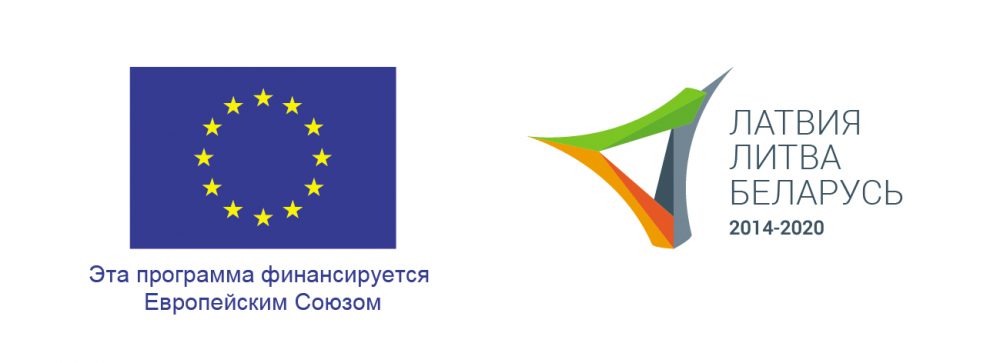
Preili Museum of History and Applied Arts (Latvia), Grodno State Museum of the History of Religion (Belarus) and Panevezys Local Lore Museum (Lithuania) joint virtual exhibition – ethnic diversity.
Preili Museum of History and Applied Arts
Old Believers’s community in Preili
Preili, like the rest of Latgale territory, has developed in the last four centuries as a multicultural and multi-confessional settlement. Historically, the largest ethnic groups that settled next to Latvians in the area of Preiļi were Russians (Old Believers) and Jews. The arrival of Old Believers into the territory of Latvia was determined by the split in the Orthodox Church in Russia caused by the reform of church ceremonies in 1653. As a result, Old Believers who did not accept the innovations introduced by Patriarch Nikon were severely persecuted and many were forced to flee to the outskirts of Russia or even leave their homeland. Some of them from the second half of the 17th century settled in Latgale, which at that time was part of the Polish-Lithuanian commonwealth. Old Believers’ settlements were also established in the vicinity of Preiļi – in 1729, an Old Believer congregation was founded 5 km from Preiļi in Moskvina, while in Preiļi the Old Believers’ congregation was founded in 1906. Preserving the traditions of their ancestors and a strong Christian faith, the Old Believers lived alongside other inhabitants of Latgale in harmony, engaged in agriculture, handicrafts, timber rafting. In the cities worked in construction, engaged in trade.
Until nowadays, Old Believers have managed to preserve their faith and cultural values, which are still nurtured and passed on to younger generations. The Preiļi Museum of History and Applied Arts holds evidence of the cultural and historical heritage of Old Believers, which includes everyday and religious objects, photographs and memoirs. In cooperation with the Old Believer community and its representatives, exhibitions are organized.
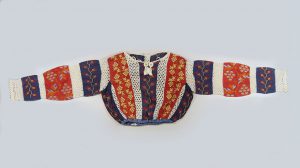
Made as a wedding blouse by Javdokija Semjonova (1902–1997) in 1920’s in Vainova parish of Rezekne district. Sewn from pieces of blue and red cotton cloth embroidered in a cross-stitch and connected by crochet bands of white cotton. Sleeve ends crocheted. The object was donated to the museum by maker’s daughter Pelageja Hrapunova. The blouse can be seen in the exposition of the Preili Museum of History and Applied Arts “Museum Stories for Latvia”.
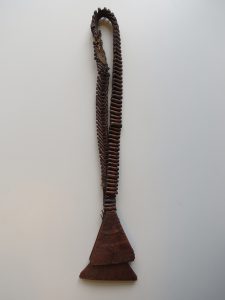
Beginning of the 20th century. Used by Vassa Loginova (1901–1990), a member of the Moskvina Old Believers Church. Obtained during the expedition “Old Believers’ Cultural Heritage” organized by Preili Museum of History and Applied Arts in 2009. In the old Russian tradition, lestovka symbolizes the stairs from earth to heaven. Made of intertwined brown leather threads – steps. The pendants are made up of four leather-covered paper triangles that symbolize the number of gospels.
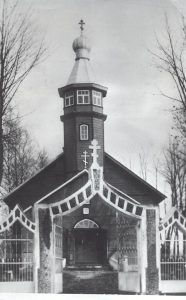
Middle of the 20th century. Preili Old Believers Church was built in the 1920s, however, it burned down and the congregation restored it from 1928 to 1938. The church was located on Raina Boulevard, in the territory of the nowadays Preili Hospital complex. During the construction of the new hospital building in 1961, the Preiļi District Council decided to demolish the church, leaving only the gate without the cross. After Latvia regained its independence, in 1992-1996 the Preili Old Believers congregtion built a new church elsewhere in the city. In 2018, the gate was restored at the historic site of the church on Raina Boulevard.
Hrodna State Museum of the History of Religion
National minorities
The multinational character of the Grodno region was developing over the centuries. Geographical location and historical events significantly influenced the ethnic diversity of the inhabitants of the city and the region. Today, large ethnic groups in the Grodno region are the Belarusians, Poles, Russians, Lithuanians, Tatars, and Jews. In addition to them, a significant contribution to the economic and cultural development of the region was made by the Germans, Ukrainians, Latvians, Armenians, French and representatives of other peoples. A lot of cultural heritage sites associated with the activities of various nationalities have survived. In the case of some peoples, the preservation of their ethnic identity was also facilitated by the fact that they historically practiced a religion different from the majority of the population did. The funds of the Grodno State Museum of the History of Religion contain many items related to the history and culture of various ethnic groups living in the city and the region.

Talliet (or tallit) is a kind of special religious clothing of the Jewish believers, which is used during the prayer. Talliet has the shape of a rectangle and somewhat resembles a coverlet. It is worn in a special way. With the help of this element of the wardrobe the believer plunges into a state of prayer and as if closes himself off from the outside world, focusing on communication with God.
The talliet presented here was made from woolen fabric in Belarus in the second half of the 20th century. There is information that special factories for the manufacture of talliets and other items of Jewish clothing appeared on our lands at the end of the 18th – first half of the 19th century. The Jewish population has retained a strong ethnic identity and a special way of life thanks to Judaism, one of the most ancient religions on Earth. Jewish communities on the territory of Belarus appeared in the 14th century. Communities in Grodno and Brest were among the first to appear.
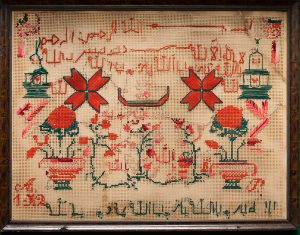
The Tatars were invited by the Grand Duke of Lithuania Vitovt to the lands of modern Belarus in the 14th century. They retained their identity mainly because they were adherents of the Islamic faith. Over time, the Tatars lost their native language and began to speak Belarusian and some other languages in everyday communication. In addition, living together with representatives of other peoples contributed to the interpenetration of traditions and the creation of special cultural phenomena such as handwritten books, household items and religious cult.
Among them, the mugirs are the most outstanding artifacts. These are beautifully designed sayings from the Quran, images of holy places or Muslim prayers. The composition of the mugir presented at the virtual exhibition consists of text and floral ornaments. In the center, the stems of flowers create two fields with inscribed appeals to Allah and the Prophet Muhammad. On the sides, there are two vases of flowers. At the top, there are images of stylized minarets, basmala formulas (a special phrase in the beginning of every surah of the Quran, except for the ninth one) and shahada (Muslim testimony of faith). Mugir is made of paper, wood and embroidered with woolen thread. The elements used in design have something in common with the Belarusian folk ornament.
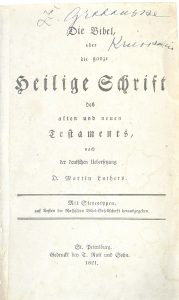
German merchants, artisans, doctors, religious leaders appeared on the Belarusian lands already in the Middle Ages. The presence of representatives of this people is noticeable in the historical city toponymy and topography: there was a German Market Square and the Evangelical Lutheran Church of St. John in Grodno (today the only one functioning in Belarus). The Germans in our lands belonged to various Christian denominations (Catholicism, Calvinism, Orthodoxy), but since the 16th century it was Lutheranism that contributed to the preservation of the German language and cultural identity.
Translation of biblical texts into languages understandable to an ordinary person and simplification of worship were one of the postulates of the Reformation. The translation of the Bible into German by Martin Luther influenced not only religious life and the spread of literacy, but also was a significant stage in the formation of the literary language. The old printed book presented here is the complete Bible translated by Martin Luther, published in 1821 in St. Petersburg by the publishing house “T. Rutt and Son”. This edition includes 39 canonical and 14 non-canonical books of the Old Testament and 27 canonical books of the New Testament. The Bible was used by the Grodno Lutheran community.
Panevėžys Local Lore Museum
National communities: “Karaites of Panevėžys”
Lithuanian Karaites are emigrants from the Crimea. Their settlement in Lithuania is shrouded in legends. It is believed that they were settled here by the Grand Duke of Lithuania Vytautas the Great. According to the privileges of the rulers, the city of Trakai was the administrative and spiritual center of the Karaites community in Lithuania.
The first information about the establishment of Karaites in Panevėžys dates to the second half of 17th century. According to the census data of the 1897, 208 of Karaites lived in Panevėžys region and 68 in the City. The census data of the 1923 shows that the number of Karaites in Panevėžys city increased to 98, while only 8 Karaites lived in the region. They were engaged in gardening, horticulture, various businesses. The Karaites of Panevėžys did not have their own cemetery in the city, so the deceased were buried in Naujamiestis.
The Karaites community of Panevėžys was officially registered in 1922. It especially prospered in the period of the Republic of Lithuania. The community, which had about one hundred and fifty members, was able to organize and publish a literary magazine “Onarmach” (engl. „Progress”) bringing out Karaites works, translations of literary works into Turkic (Karaim) language and a chronicle of everyday life. Three editions of the magazine have been published. While Vilnius and Trakai were occupied by Poland, in July 1936, the Panevėžys Karaites community was reorganized into the Lithuanian Karaites society.
Out of all the members of the former “Karaites” community, 15 Karaites currently live in Panevėžys and 3 in Naujamiestis. They are all at an honorable age.
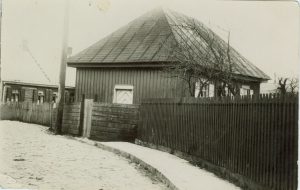
It is not known exactly when the Karaites house of worship was built in Panevėžys. It is believed that they first opened in early 19th century. Kenesa was built at the corner of Sodų and Ramygalos streets. In 1938, the building was reconstructed: a new brick building of eclectic architecture was built instead of the wooden one. In 1952, by the decision of the Panevėžys City Executive Committee, the Kenesa was closed due to the fact that the Karaites did not have their own priest and no services were held there. In 1970, during the construction of a residential house, the building was demolished. In 1995, a monument was unveiled on the site of the former Karaites Kenesa.
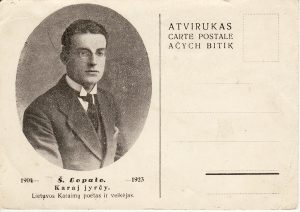
Š. Lopato was born in May 14, 1904, in Trakai. In 1911–1915 he studied at the Trakai Karaites primary school. During the First World War he studied at the St. Petersburg Boys’ Gymnasium, in 1916–1920 he studied at the Alexander Spiritual School in Yevpatoria city, Crimea. 1920 he returned to Lithuania. Since 1922, he has lived and worked in Panevėžys, has been actively involved in public activities, was one of the founders of the “Onarmach” (engl. “Progress”) association, and there he worked as the secretary. In the Karaites community, he also performed the duty of a priest: he holded worship services in Kenesa. In 1923, he graduated the Panevėžys School of Forest Technicians and was appointed Deputy Head of the Pasvalys Forestry Council. Few months later, he was murdered by illegal loggers. He was buried in the Naujamiestis cemetery. Š. Lopato was famous as a poet of Karaites. There was not much of his creative work, but it was very mature and melodic. After the death of the poet his poems were published in the magazine „Onarmach” in Panevėžys and in the magazine “Karaj awazy” (engl. “Karaites Voice”) in Lutsk. The poems were written in excellent Karaim language, some of them were translated into Lithuanian. Despite a short life, Š. Lopato was one of the most prominent members of the Karaites community in Lithuania.
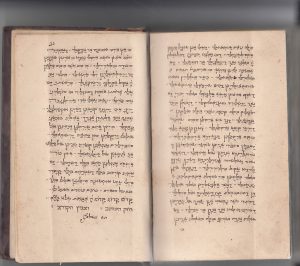
It is a 226-page manuscript written in the Karaim Ashkenazi language. It consists of three parts. First part contains written liturgical poetry and various forms of prayers, translated into Turkic language. In the second part there are prayers and liturgical poetry for the Sabbath and for the beginning of the month (next to some poems there is a Turkic translation), also there are prayers and blessings for various occasions. At the end there is a list of births and deaths of the rewriter Zvulun Roe family from 1820 to 1923. In 2019, this rare and valuable exhibit of the Panevėžys Local Lore Museum was described and catalogued in detail by the National Library of Israel.
About the project ENI-LLB-1-244 “Promotion of historical and culture cross border through museums innovations”
The project aims to build a cross border cooperation platform creating preconditions for ensuring the increasing interest of tourists and visitors about the cultural and historical heritage in the border area of Latvia, Lithuania and Belarus.
This project is funded by the European Union
Project budget: 367 864.64 EUR, EU funding 331 078.17 EUR
Project implementation period: 1st of June 2020 – 31st of May 2022
European Neighbourhood Instrument Cross-border Cooperation Programme Latvia-LithuaniaBelarus 2014-2020
